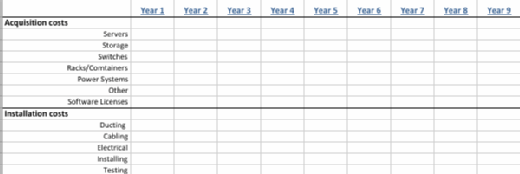
Brigida Soriano - Fotolia
This data center cost calculator keeps you on budget
Calculating every data center expense can be challenging, but with the right spreadsheet -- and formulas -- you will accurately assess the total cost.
Calculating the cost of setting up a data center is complicated. Total data center cost spans from the capital investment in building or acquiring a facility, to the fine details of operating expenses, such as maintenance for fire suppression systems.
The attached data center cost calculator covers capital and operating expenses over a nine-year window for a traditional data center building, not containerized options. The spreadsheet is meant as a guide and a starting point for discussion. It may differ from your company's accounting schemes, due to taxes or other financial rules.
To determine total data center cost, break out expenses by the capital cost (Capex) of the facility itself, facility operating costs (Opex) and each pod -- block of units installed together -- of equipment that runs in the data center. Pods are tracked, depreciated and otherwise handled independently of other unit pods. The results of the pod cost calculations should be manually transferred to the Capex and Opex sheet of the attached spreadsheet for the data center.
Colocation providers may use this calculator as a basis for determining a pricing structure, although the colocation company does not always control what IT equipment is used, how often it is refreshed or how it operates.
The template works for small to large data centers. The network operations center (NOC) only exists in large centers, but a switch room or other area might take its place in mid-tier setups. Treat the NOC like a pod for total cost of ownership (TCO) calculation purposes.
Timelines are annual, for nine years: installation plus eight years of operation. It's easy to expand the number of years if needed, or to move to a quarterly or monthly basis, but these make for very unwieldy spreadsheets, and are probably an unnecessary burden given out-year planning accuracy.
Capex for the facility
Several capital investments contribute to data center cost, each consisting of numerous line-items.
Land purchase, meaning the cost of the land, is not depreciable.
Utilities installation varies by project. For greenfield facilities, you must bring utilities on-site, which can be a substantial expense. These need to be connected in the building as well.

Account for improvements, including fences and landscaping, as well as basic infrastructure, like connecting to roadways.

Data hall charges include the raised floors, ceilings and duct work, cabling and more. These can occur at once during facility construction, or staged out over years. If staggered, input the cost in the planned year.
For fire suppression, choose sprinklers or clean agent-based systems, or a combination.

Depending on the data center size, some power systems costs may be zeroed out. You'll need to price out main infrastructure and backup systems.

For cooling, most data centers still use chillers, unless you're deploying containerized IT equipment or a free cooling design. Include an environmental controls package as well.

A data center build racks up plenty of miscellaneous costs. Security systems are one necessary expense, ranging from metal detectors to cell phone jammers and explosive sniffers. For small data centers, security might just be a steel door and good locks.
Other expenses might depend on the location; isolated data centers in snowy regions require an emergency food supply in the lunchroom, for example.

Based on the capital used, there is a depreciation section in the downloadable spreadsheet. The rules are complicated, and there are judgment calls to make on the useful life of different items, so provide a specific calculation to your environment.
Opex for the facility
Data center operating costs include a range of utilities -- electricity and water needed just for the physical data center infrastructure, personnel and contractors, as well as the peripheral licenses and taxes that apply to the data center.
Utilities should not cover the power draw of pods of IT equipment, which will be calculated later.
Taxes and licenses vary by jurisdiction and, potentially, facility size. Larger data centers often get tax breaks for a number of years, or grants, to incentivize building in a certain location.
Personnel costs aren't the same for data centers as other businesses -- many installations run with small staffs. Include everyone on both the IT and facilities sides in the calculations.
Don't forget to add in benefits costs.
Data centers utilize contract services heavily while a facility gets up and running. For ongoing operations, departments such as janitorial and security are often outsourced. Union labor may be required, and outside electrical contractors must come in for some situations.
Depreciation is copied from the data center Capex page.
Variable Expenses
This section counts the cost of each pod of gear, including the NOC. The numbers come from a set of pod pages that follow. If you add, or subtract, lines on the spreadsheet, remember to change the SUM formula.

Expense for a pod
Every data center cost to this point has been for the shared facility. The pods (including a NOC where appropriate) complete the total calculation. Pod cost delineation follows the same format as facilities, with sections for capital and operating expenses. Line items that don't apply to unit installations are omitted.
Start with the capital costs of acquisition and installation for all the IT equipment required, from servers and storage to software licenses, cabling and peripheral power.

Operations costs, similar to those described above, cover the utilities used for pods, licensing and taxes per pod, and the personnel assigned to the equipment. Further costs are incurred around maintenance and equipment refreshes.

Maintenance services include regular attention to power systems and changing filters. This can be handled in-house or contracted out.

Refresh and removal costs are significant, especially with any write-offs. The trend in today's data centers is shorter life expectancy for gear -- typically three to four years. A shorter equipment life means an accelerated depreciation, or else the residual value at sale of used equipment needs to be reflected in the charts. Jurisdiction affects how this is done.

About the author:
Jim O'Reilly is a consultant focused on storage and cloud computing. He previously held top positions at Germane Systems -- creating ruggedized servers and storage for the U.S. submarine fleet -- as well as SGI/Rackable and Verari, startups Scalant and CDS, and PC Brand, Metalithic, Memorex-Telex and NCR.







